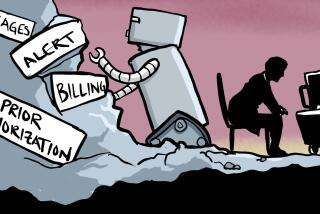If the Doctor Is Busy, Perhaps Dr. Robot Will Do
- Share via
BALTIMORE — The newest staff member at Johns Hopkins Hospital stands just over 5 feet and looks like an oversized vacuum cleaner with a video screen for a head.
“Dr. Robot” is part of a study at Hopkins that asks: If a patient’s own doctor isn’t physically available, would that patient rather see and talk with his or her doctor through an interactive robot or see a substitute physician in per- son?
Dr. Louis Kavoussi, who is conducting the feasibility study, says the answer, so far, favors Dr. Robot.
“All these patients have a preexisting relationship with me,” said Kavoussi, a professor and vice chairman of Hopkins’ urology department.
“So this is not an impersonal visit. I know them.... They’d absolutely rather see me, even if it’s virtual.”
The study, which will involve about 40 patients, is designed to gauge their attitudes toward Dr. Robot.
Kavoussi, a member of the scientific advisory board for InTouch Health Inc., the company that makes the robot, said he is optimistic that the robot is “going to be accepted by patients as a mechanism to interact with their physicians.”
If successful, the study will be followed by a larger one, with more patients at multiple hospitals, to make sure that the care rendered by the robots is equivalent to in-person care.
The current study is expected to be completed this month.
Kavoussi said the robots could one day be used to help treat patients when it’s not possible to send physicians, such as in military operations and natural disasters.
With the robot -- which has infrared sensors, a movable video screen, a zoom video camera, a microphone and a speaker -- doctors can examine patients from hundreds of miles away, using a joystick and an Internet connection.
“You get a lot of information from looking at a patient’s face in terms of how they’re doing -- their gestures, their aura,” Kavoussi said. “All that can come across very, very well” through the robot.
Dr. Stephen Schoenbaum of the Commonwealth Fund, a private foundation that supports research on health-care policy and counts as a member the president of Johns Hopkins University, said the robots can’t replace human contact.
“What if the patient says, ‘I’m having a lot of pain in my stomach?’ Can this robot examine a belly?” Schoenbaum said.
But he concedes that the robot could be an important first step in treating patients who are in places where doctors cannot physically be.
“What you’re really talking about here is how do you bring sophisticated medical services -- not to people sitting in Hopkins hospital, where they can get them anyway -- but to people who don’t have that advantage?” Schoenbaum said.
Dr. Eric Dobkin, director of the surgical intensive care unit at Hartford Hospital and an associate professor of surgery at the University of Connecticut, said the robot could be useful for physicians who wanted to answer their patients’ questions while they were traveling.
“The risk to physicians is that we’d be tempted to always be looking at our patients and wouldn’t be able to relax,” Dobkin said. “I also imagine that there’s a group of patients who would feel it was too impersonal.... They’d rather have a human touch and examine them.
“There is a role for robotics,” he added. “But I don’t think it could substitute for a physical examination.”
Kavoussi said there are still a few technical problems: Recently, engineers had to be called in when the chain link mechanism on one of the front wheels jammed.
But he said the robot’s “real-time” interaction has impressed many patients.
When the robot rolled into Elizabeth Mints’ room after her kidney surgery, she said she was surprised to see how clear Kavoussi’s image appeared on the video monitor and how easily she could communicate with him through the robot.
“If he can’t be there in person, this is a good substitute. You could see him smile and laugh when I said a couple things,” said Mints, 56, a retired police officer from Edgewater.
“It made it seem not like you were talking to a machine. You got a sense that Dr. Kavoussi was on the other side.”






